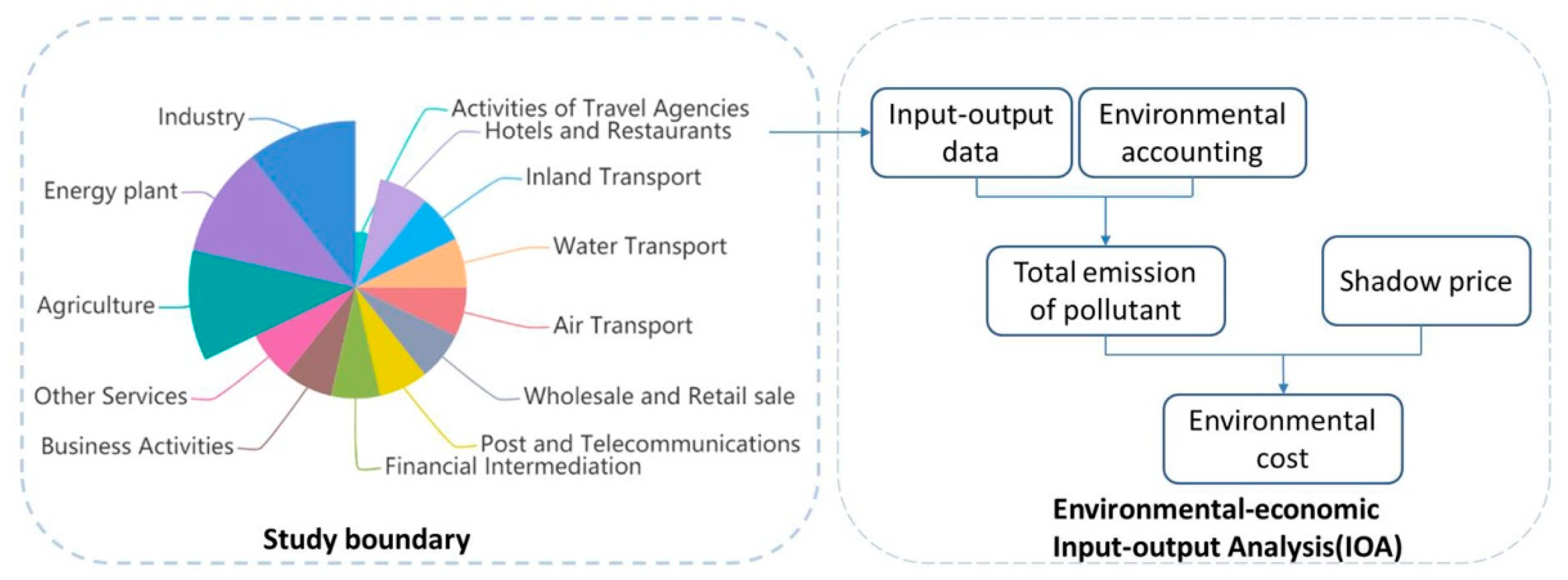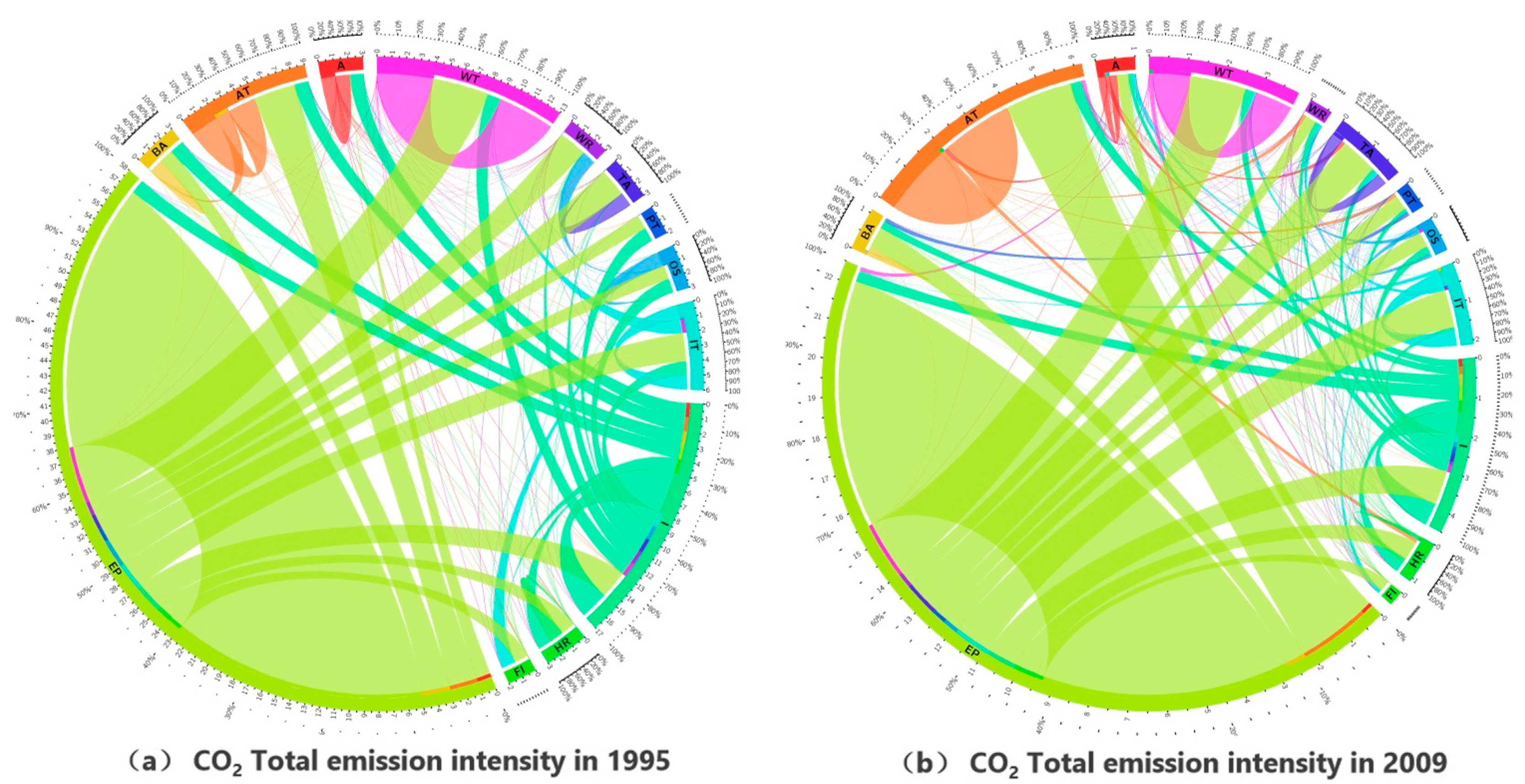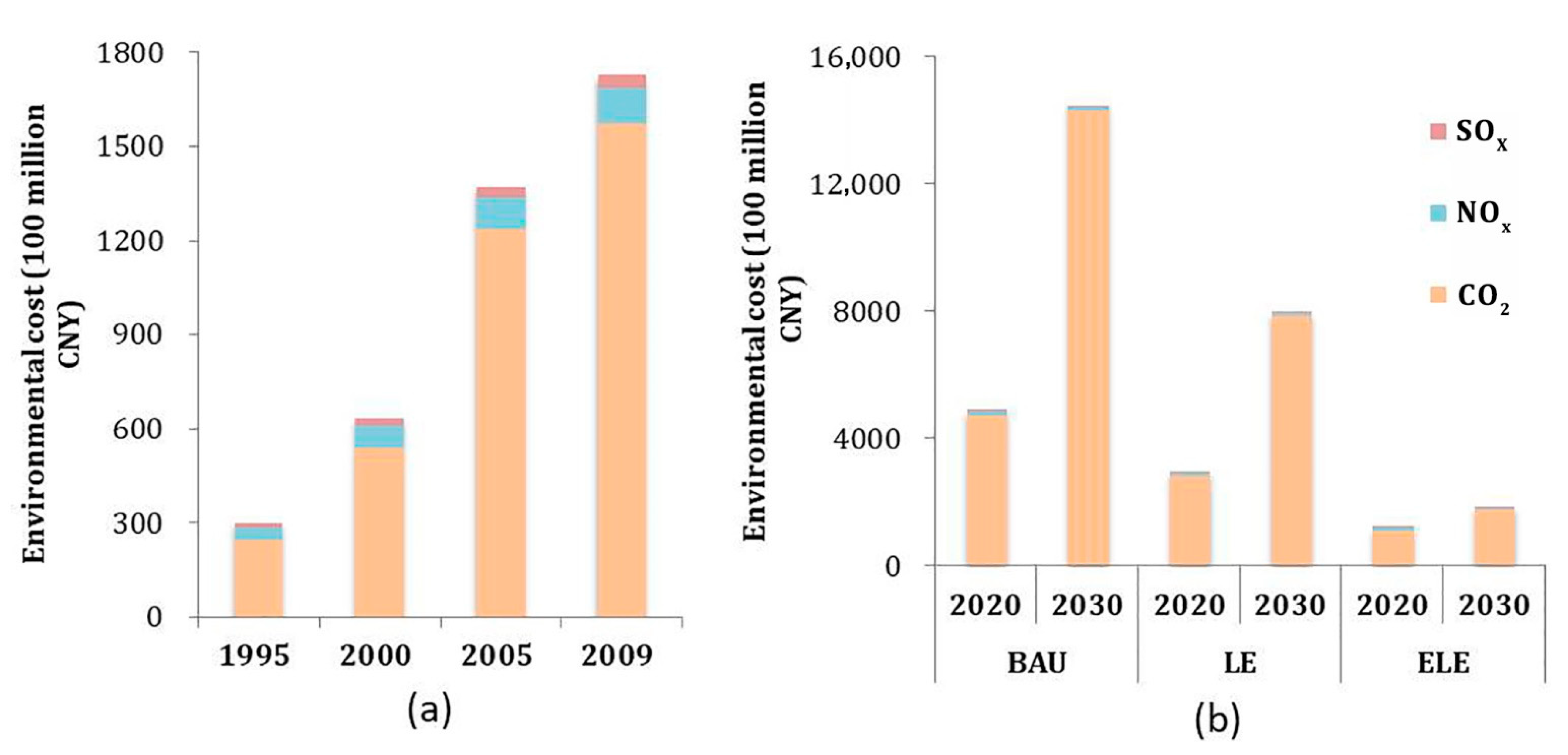Assessing the Environmental Impact and Cost of the Tourism-Induced CO2, NOx, SOx Emission in China
Abstract
:1. Introduction
2. Materials and Methods
2.1. Study Framework and Boundary Definition
2.2. Environmental-Economic Input-Output Model
2.3. Scenario Analysis of Emission Abatement Potential
3. Results
3.1. Direct Emission and Direct Emission Intensity
3.2. Total Emission and Total Emission Intensity
3.3. Total Emission by Sector and by Pollutant
3.3.1. CO2
3.3.2. NOx
3.3.3. SOx
3.4. Environmental Cost of Tourism-Induced Pollutant and Prediction
4. Discussion
4.1. Tourism-Induced Direct and Indirect Environmental Impacts
4.2. Sustainable Mobility Supporting Tourism Sustainability
4.3. Emission Abatement Potential and Environmental Cost of Tourism Industry
5. Conclusions
Supplementary Materials
Author Contributions
Funding
Institutional Review Board Statement
Informed Consent Statement
Data Availability Statement
Acknowledgments
Conflicts of Interest
References
- WTTC. Travel & Tourism Global Economic Impact & Trends; World Travel & Tourism Council: London, UK, 2019. [Google Scholar]
- Mi, B. On the sustainable development system of regional tourism. J. Chem. Pharm. Res. 2014, 6, 854–858. [Google Scholar]
- Gössling, S.; Peeters, P. Assessing tourism’s global environmental impact 1900–2050. J. Sustain. Tour. 2015, 23, 639–659. [Google Scholar] [CrossRef]
- Gössling, S. Global environmental consequences of tourism. Glob. Environ. Chang. 2002, 12, 283–302. [Google Scholar] [CrossRef]
- Peeters, P.; Dubois, G. Tourism travel under climate change mitigation constraints. J. Transp. Geogr. 2010, 18, 447–457. [Google Scholar] [CrossRef]
- Scott, D.; Amelung, B.; Becken, S.; Ceron, J.-P.; Dubois, G.; Gössling, S.; Peeters, P.; Simpson, M. Climate Change and Tourism: Responding to Global Challenges; World Tourism Organization: Madrid, Spain, 2008. [Google Scholar]
- Buckley, R.C. Sustainable tourism: Research and reality. Ann. Tour. Res. 2012, 39, 528–546. [Google Scholar] [CrossRef] [Green Version]
- Lenzen, M.; Sun, Y.-Y.; Faturay, F.; Ting, Y.-P.; Geschke, A.A. The carbon footprint of global tourism. Nat. Clim. Chang. 2018, 8, 522–528. [Google Scholar] [CrossRef]
- Zhang, J.K.; Zhang, Y. Tourism, economic growth, energy consumption, and CO2 emissions in China. Tour. Econ. 2020. Available online: https://journals.sagepub.com/doi/10.1177/1354816620918458 (accessed on 21 April 2020). [CrossRef]
- Sajjad, F.; Noreen, U.; Zaman, K. Climate change and air pollution jointly creating nightmare for tourism industry. Environ. Sci. Pollut. Res. 2014, 21, 12403–12418. [Google Scholar] [CrossRef]
- Zhong, L.S.; Deng, J.Y.; Song, Z.W.; Ding, P.Y. Research on environmental impacts of tourism in China: Progress and prospect. J. Environ. Manag. 2011, 92, 2972–2983. [Google Scholar] [CrossRef]
- Roman, M.; Niedziółka, A.; Krasnodębski, A. Respondents’ Involvement in Tourist Activities at the Time of the COVID-19 Pandemic. Sustainability 2020, 12, 9610. [Google Scholar] [CrossRef]
- Fermani, A.; Sergi, M.R.; Carrieri, A.; Crespi, I.; Picconi, L.; Saggino, A. Sustainable Tourism and Facilities Preferences: The Sustainable Tourist Stay Scale (STSS) Validation. Sustainability 2020, 12, 9767. [Google Scholar] [CrossRef]
- Scott, D.; Peeters, P.; Grössling, S. Can tourism deliver its “aspirational” emission reduction targets? J. Sustain. Tour. 2010, 18, 393–408. [Google Scholar] [CrossRef]
- Becken, S.; Patterson, M. Measuring national carbon dioxide emissions from tourism as a key step towards achieving sustainable tourism. J. Sustain. Tour. 2006, 14, 323–338. [Google Scholar] [CrossRef]
- Jones, C. Scenarios for greenhouse gas emissions reduction from tourism: An extended tourism satellite account approach in a regional setting. J. Sustain. Tour. 2013, 21, 458–472. [Google Scholar] [CrossRef]
- Kuo, N.-W.; Chen, P.-H. Quantifying energy use, carbon dioxide emission, and other environmental loads from island tourism based on a life cycle assessment approach. J. Clean. Prod. 2009, 17, 1324–1330. [Google Scholar] [CrossRef]
- Baster, J. Input-output analysis of tourism benefits: Lessons from Scotland. Int. J. Tour. Manag. 1980, 1, 99–108. [Google Scholar] [CrossRef]
- Briassoulis, H. Methodological issues: Tourism input-output analysis. Ann. Tour. Res. 1991, 18, 485–495. [Google Scholar] [CrossRef]
- Becken, S.; Simmons, D.G. Understanding energy consumption patterns of tourist attractions and activities in New Zealand. Tour. Manag. 2002, 23, 343–354. [Google Scholar] [CrossRef]
- Gössling, S. Sustainable tourism development in developing countries: Some aspects of energy use. J. Sustain. Tour. 2000, 8, 410–425. [Google Scholar] [CrossRef]
- Katircioglu, S.T.; Feridun, M.; Kilinc, C. Estimating tourism-induced energy consumption and CO2 emissions: The case of Cyprus. Renew. Sustain. Energy Rev. 2014, 29, 634–640. [Google Scholar] [CrossRef]
- Suna, Y.-Y.; Cadarsob, M. Tourism carbon footprint inventories: A review of the environmentally extended input-output approach. Ann. Tour. Res. 2020, 82, 102928. [Google Scholar] [CrossRef]
- Tabatchnaia-Tamirisa, N.; Loke, M.K.; Leung, P.S.; Tucker, K.A. Energy and tourism in Hawaii. Ann. Tour. Res. 1997, 24, 390–401. [Google Scholar] [CrossRef]
- Huang, Q.Y. The Research on Sustainable Development of Tourism from the Perspective of Enviornmental Cost; Nankai University: Tianjin, China, 2011. [Google Scholar]
- Huang, W.Y. Tourism environment cost economics interpretation. Ind. Surv. 2013, 4, 130–133. [Google Scholar]
- Liu, Y. Study on Environmental Cost Accounting of Tourism Industry in China; China University of Geosciences: Beijing, China, 2015. [Google Scholar]
- Chen, J.H.; Xie, J.H. An review of environmental costs. Times Financ. 2013, 12, 316–320. [Google Scholar]
- Lee, S.-C.; Oh, D.; Lee, J. A new approach to measuring shadow price: Reconciling engineering and economic perspectives. Energy Econ. 2014, 46, 66–67. [Google Scholar] [CrossRef]
- Jain, R.K.; Kumar, S. Shadow price of CO2 emissions in Indian thermal power sector. Environ. Econ. Policy Stud. 2018, 20, 879–902. [Google Scholar] [CrossRef] [Green Version]
- Wang, K.; Che, L.N.; Ma, C.B.; Wei, Y.M. The shadow price of CO2 emissions in China’s iron and steel industry. Sci. Total Environ. 2017, 598, 272–281. [Google Scholar] [CrossRef]
- Maethee, M.; Andrew, L.J. Estimating the Shadow Prices of SO2 and NOx for U.S. Coal Power Plants: A convex nonparametric least squares approach. Energy Econ. 2012, 34, 723–732. [Google Scholar]
- Lee, C.Y.; Zhou, P. Directional Shadow Price Estimation of CO2, SO2 and NOx in the United States Coal Power Industry 1990–2010. Energy Econ. 2015, 51, 493–502. [Google Scholar] [CrossRef]
- Färe, R.; Grosskopf, S.; Noh, D.-W.; Weber, W. Characteristics of a polluting technology: Theory and practice. J. Econom. 2005, 126, 469–492. [Google Scholar] [CrossRef]
- Leontief, W. The Structure of American Economy; IASP Publishing: New York, NY, USA, 1941. [Google Scholar]
- Leontief, W. Studies in the Structure of the American Economy; Oxford University Press: London, UK, 1953. [Google Scholar]
- Carnegie Mellon University Green Design Institute (CMUGDI). Economic Input-Output Life Cycle Assessment (EIO-LCA). 2002. Available online: http://www.eiolca.net (accessed on 1 January 2008).
- Hendrickson, C.; Horvath, A.; Joshi, S.; Lave, L. Peer reviewed: Economic input-output models for environmental life-cycle assessment. Environ. Sci. Technol. 1998, 32, 184A–191A. [Google Scholar] [CrossRef]
- World Input-Output Table (WIOD) Database. 2013. Available online: http://www.wiod.org/home (accessed on 9 January 2021).
- Deng, X.L. Path Choice for Integrative Development of China’s Tourism Industry—Based on Input-Output Analysis. Innovation 2020, 1, 42–53. [Google Scholar]
- Chen, H.L.; Nie, W.L. Slacks-based efficiency measures and spatial analysis for measuring the shadow price of Chinese carbon emissions. Acta Ecol. Sin. 2018, 38, 5178–5186. [Google Scholar]
- Du, L.M.; Hanley, A.; Wei, C. Estimating the Marginal Abatement Cost Curve of CO2 Emissions in China: Provincial Panel Data Analysis. Energy Econ. 2015, 48, 217–229. [Google Scholar] [CrossRef] [Green Version]
- Zhang, F.F.; Xing, J.; Zhou, Y.; Wang, S.X.; Zhao, B.; Zheng, H.T.; Zhao, X.; Chang, H.Z.; Jang, C. Estimation of abatement potentials and costs of air pollution emissions in China. J. Environ. Manag. 2020, 260, 110069. [Google Scholar] [CrossRef]
- Liu, J.; Chen, X.P.; Zhang, Z.L. Features and factors decomposition of carbon dioxide emission of China’s tourism industry. Resour. Ind. 2017, 19, 67–76. [Google Scholar]
- Liu, X.X.; Hu, X.; Zhou, H. An Analysis of the Measurement of Correlationof China’s Tourism Industry and Macroeconomic Effects—Based on the Perspective of Input-output ables in 2002 and 2007. Tour. Trib. 2011, 26, 31–37. [Google Scholar]
- Gössling, S.; Michael, H.C.; Peeters, P. The future of tourism: Can tourism growth and climate policy be reconciled? A mitigation perspective. Tour. Recreat. Res. 2010, 35, 119–130. [Google Scholar] [CrossRef]
- Dubois, G.; Peeters, P.; Ceron, J.P.; Gössling, S. The future tourism mobility of the world population: Emission growth versus climate policy. Transp. Res. Part A Policy Pract. 2011, 45, 1031–1042. [Google Scholar] [CrossRef]
- Høyer, K.G. Sustainable tourism or sustainable mobility? The Norwegian case. J. Sustain. Tour. 2000, 8, 147–160. [Google Scholar] [CrossRef]
- Eijgelaar, E.; Thaper, C.; Peeters, P. Antarctic cruise tourism: The paradoxes of ambassadorship, last chance tourism and greenhouse gas emissions. J. Sustain. Tour. 2010, 18, 337–354. [Google Scholar] [CrossRef]
- Lamers, M.; Amelung, B. The environmental impacts of tourism, to Antarctica. A global perspective. In Tourism and Climate Change Mitigation. Methods, Greenhouse Gas Reductions and Policies; Peeters, P.M., Ed.; NHTV: Breda, The Netherlands, 2007; pp. 51–62. [Google Scholar]
- Peeters, P.M. Developing a long-term global tourism transport model using a behavioural approach: Implications for sustainable tourism policy making. J. Sustain. Tour. 2013, 21, 1049–1069. [Google Scholar] [CrossRef]
- Campen, J.T. Benefit, Cost, and Beyond: The Political Economy of Benefit-cost analysis. Atl. Econ. J. 1986, 18, 79–88. [Google Scholar]
- Li, J.F.; Li, M.Y. On the calculation of tourism industry and tourism adding value. Tour. Trib. 1999, 5, 16–20. [Google Scholar]
- Tisdell, C.A. Foreign tourism: Benefits to China and contribution to development. In Economic Development in the Contexts of China: Policy Issues and Analysis; Tisdell, C.A., Ed.; St Martins Press: London, UK, 1993. [Google Scholar]
- Mike, R. Socio-economic and environmental cost–benefit analysis for tourism products—A prototype tool to make holidays more sustainable. Tour. Manag. Perspect. 2013, 8, 114–125. [Google Scholar]
- Dwyer, L.J.; Forsyth, P. Measuring the benefits and yield from foreign tourism. Int. J. Soc. Econ. 1997, 24, 223–236. [Google Scholar] [CrossRef]











| Sector Classification | Code | Sector | Stripping Coefficient of Tourism Consumption b | |
|---|---|---|---|---|
| Tourism-related industry | Agriculture | c1 | Agriculture, Hunting, Forestry, and Fishing | 0 |
| Energy plant | c8 | Coke, Refined Petroleum, and Nuclear Fuel | 0 | |
| c17 | Electricity, Gas, and Water Supply | |||
| Industry | c2 | Mining and Quarrying | 0 | |
| c3 | Food, Beverages, and Tobacco | |||
| c4 | Textiles and Textile Products | |||
| c5 | Leather, Leather, and Footwear | |||
| c6 | Wood and Products of Wood and Cork | |||
| c7 | Pulp, Paper, Paper, Printing, and Publishing | |||
| c9 | Chemicals and Chemical Products | |||
| c10 | Rubber and Plastics | |||
| c11 | Other Non-Metallic Mineral | |||
| c12 | Basic Metals and Fabricated Metal | |||
| c13 | Machinery, Nec | |||
| c14 | Electrical and Optical Equipment | |||
| c15 | Transport Equipment | |||
| c16 | Manufacturing, Nec; Recycling | |||
| c18 | Construction | |||
| c19 | Sale, Maintenance, and Repair of Motor Vehicles and Motorcycles; Retail Sale of Fuel | |||
| Tourism industry | Wholesale and Retail Trade | c20 | Wholesale Trade and Commission Trade, Except of Motor Vehicles and Motorcycles | 0.07 |
| c21 | Retail Trade, Except of Motor Vehicles and Motorcycles; Repair of Household Goods | |||
| Hotels and Restaurants | c22 | Hotels and Restaurants | 0.46 | |
| Inland Transport | c23 | Inland Transport | 0.15 | |
| Water Transport | c24 | Water Transport | 0.15 | |
| Air Transport | c25 | Air Transport | 0.40 | |
| Activities of Travel Agencies a | c26 | Other Supporting and Auxiliary Transport Activities; Activities of Travel Agencies | 1 | |
| Post and Telecommunications | c27 | Post and Telecommunications | 0.08 | |
| Financial Intermediation | c28 | Financial Intermediation | 0.01 | |
| Business Activities | c30 | Renting of M&Eq and Other Business Activities | 0.01 | |
| Other Services | c29 | Real Estate Activities | 0.01 | |
| c31 | Public Admin and Defence; Compulsory Social Security | |||
| c32 | Education | |||
| c33 | Health and Social Work | |||
| c34 | Other Community, Social and Personal Services | |||
| c35 | Private Households with Employed Persons | |||
| Scenario a | Year | CO2 Total Emission Intensity Reduction Percentage | Total Emission Reduction Percentage | Annual Increase Rate of Tourism Consumption | |
|---|---|---|---|---|---|
| NOx | SOx | ||||
| BAU | 2020 | as 2009 | as 2009 | as 2009 | 12% |
| 2030 | as 2009 | as 2009 | as 2009 | 12% | |
| LE | 2020 | −40% | −23% | −25% | as BAU |
| 2030 | −60% | −46% | −50% | as BAU | |
| ELE | 2020 | −45% | −23% | −25% | 6% |
| 2030 | −65% | −46% | −50% | 6% | |
Publisher’s Note: MDPI stays neutral with regard to jurisdictional claims in published maps and institutional affiliations. |
© 2021 by the authors. Licensee MDPI, Basel, Switzerland. This article is an open access article distributed under the terms and conditions of the Creative Commons Attribution (CC BY) license (http://creativecommons.org/licenses/by/4.0/).
Share and Cite
Shi, Y.; Yu, M. Assessing the Environmental Impact and Cost of the Tourism-Induced CO2, NOx, SOx Emission in China. Sustainability 2021, 13, 604. https://doi.org/10.3390/su13020604
Shi Y, Yu M. Assessing the Environmental Impact and Cost of the Tourism-Induced CO2, NOx, SOx Emission in China. Sustainability. 2021; 13(2):604. https://doi.org/10.3390/su13020604
Chicago/Turabian StyleShi, Yalan, and Miaojing Yu. 2021. "Assessing the Environmental Impact and Cost of the Tourism-Induced CO2, NOx, SOx Emission in China" Sustainability 13, no. 2: 604. https://doi.org/10.3390/su13020604






